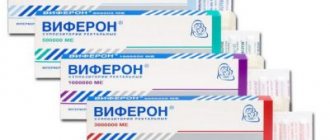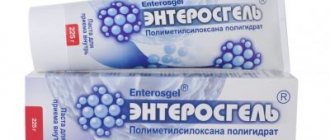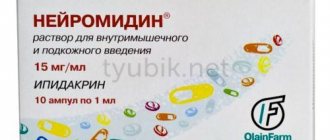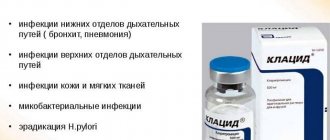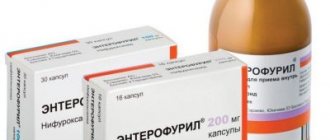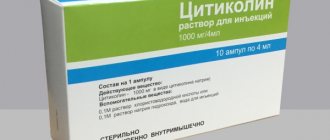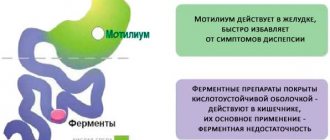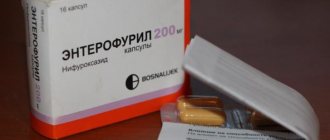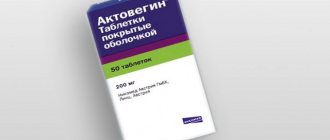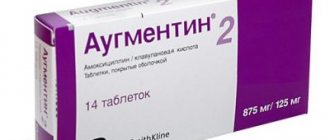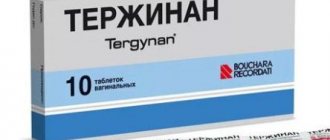Compound
| Syrup | 10 ml |
| active substances: | |
| salbutamol sulfate (equivalent to salbutamol) | 2 mg |
| Bromhexine hydrochloride | 4 mg |
| guaifenesin | 100 mg |
| excipients: sucrose (sugar); sorbitol (70% solution); glycerol (glycerol); propylene glycol; sodium benzoate; citric acid monohydrate; sorbic acid; dye “Sunset” yellow (FCF); menthol (levomenthol); blackcurrant flavor (blackcurrant flavor ID20158); pineapple flavor (pineapple flavor super “PH”); purified water |
Ascoril or Joset - which is better?
Joset is an inexpensive structural analogue of ascoril. The main components of the syrups are identical, as are their dosages, the only difference is in the auxiliary components.
The list of indications, possible side effects, and established contraindications is also similar.
Like the original Ascoril, Joset is used in pediatric practice from the age of 2, strictly under the supervision of a doctor. The duration of therapy is determined by the established diagnosis.
However, unlike askoril, a similar joset is produced only in the form of a 100 ml syrup. That is, for an adult patient, one bottle for a course of treatment is not enough, so therapy can cost even more than the cost of Ascoril.
Pharmacodynamics
The combined drug has a bronchodilator, expectorant and mucolytic effect.
Salbutamol is a bronchodilator that stimulates beta2-adrenergic receptors of the bronchi, blood vessels and myometrium. Prevents or eliminates bronchospasm, reduces resistance in the respiratory tract, increases the vital capacity of the lungs. Causes expansion of the coronary arteries, does not reduce blood pressure.
Bromhexine is a mucolytic agent. Has an expectorant effect, improves sputum discharge.
Guaifenesin is a mucolytic agent that reduces the surface tension of the structures of the bronchopulmonary apparatus; stimulates secretory cells of the bronchial mucosa that produce neutral polysaccharides, depolymerizes acidic mucopolysaccharides, reduces the viscosity of sputum, facilitates the removal of sputum and promotes the transition of a non-productive cough to a productive one.
How to choose an analogue?
With the development of infectious and inflammatory diseases of the respiratory tract, bronchodilators and expectorants are used. Usually the drug has all these actions, since it consists of several active ingredients. Doctors often prescribe Ascoril. But some patients may experience side effects or have contraindications. An analogue is selected according to the following principles:
- a medicine of lower cost, produced by Russian manufacturers, therefore does not require additional production costs;
- other active ingredients that do not cause dyspeptic reactions, neurological disorders, local or systemic allergies.
To select an analogue, it is recommended to act independently. Even a pharmacist working in a pharmacy will not be able to accurately select a medicine that is suitable for a person. They turn to a therapist, infectious disease specialist, or pulmonologist to accurately select a remedy that causes an effect, but does not have a negative effect. One of the following medications is recommended:
- Erespal;
- Lorkof;
- Joset;
- Lazolvan;
- Ambrobene;
- Ambroxol.
Some people select an analogue depending on the form of release. For example, if Ascoril tablets are not suitable, they can use Lazolvan solution. It can be used both internally and as inhalation. The second option is easier to tolerate, without consequences.
When is Erespal needed?
Erespal is a syrup for oral use based on fenspiride hydrochloride. The active component eliminates the inflammatory reaction and expands the spasmodic bronchi. Mucus is liquefied and removed. Indications for use:
- pharyngitis, laryngitis;
- tracheitis, bronchitis, bronchial asthma;
- hoarse voice, cough that develops with diseases of the respiratory system;
- respiratory tract infections with cough in combination therapy with antibiotics;
- sinusitis, otitis media
Side effects develop with prolonged use. But they appear only in a small percentage of patients. Identifies the following negative consequences:
- vascular disorders in the form of tachycardia, arrhythmia, uneven heartbeat, decreased blood pressure;
- digestive tract disorder, dyspepsia, impaired stool formation (diarrhea or constipation), vomiting;
- local and systemic allergic reactions including urticaria, anaphylactic shock, angioedema.
The medicine is contraindicated for minor patients with individual intolerance. If side effects occur, stop use immediately. Do not wait for improvement, otherwise your health will gradually worsen. This is especially true for patients with heart disease, vascular disease, and stomach ulcers.
How is Joset effective?
Joset is a syrup with a combined effect. It occurs due to salbutamol, bromhexine, guaifenesin, menthol. When they influence the respiratory system, the following effects are formed:
- bronchodilator;
- expectorant;
- mucolytic.
The drug is used for bronchial asthma and bronchitis, emphysema, chronic obstructive pulmonary disease, bronchitis and tracheitis. It is prescribed in complex therapy for the treatment of pulmonary tuberculosis in order to remove sputum and not cause a secondary infection. Sputum is quickly eliminated and does not move down the respiratory system.
Adverse reactions include neuralgia, digestive disorders, increased heart rate, drop in blood pressure, and allergies.
The medicine has many contraindications for use. Among them are serious diseases of the cardiovascular system, diabetes mellitus, liver or kidney failure, stomach and duodenal ulcers, pregnancy, and lactation. If you use the product for a long time, guaifenesin will turn your urine pink. But this does not mean that bleeding has occurred in the urinary tract.
If you use an excessively large amount of the drug, an overdose will occur. Symptoms include increased side effects. Symptomatic therapy is carried out.
How is Lazolvan useful?
Lazolvan is a solution for internal and inhalation use. The release form is selected depending on the severity of the disease. Contains ambroxol hydrochloride. Due to it, the production of pulmonary surfactant increases, mucociliary clearance increases, and sputum discharge is facilitated. It quickly liquefies and is discharged outside. The sputum does not go down, so complications of the disease do not form.
It is necessary to observe the dosage and course of application, since it is possible to liquefy the sputum, which will lead to flow down the bronchial tree.
The medicine is indicated for use in acute and chronic bronchitis, pneumonia, chronic obstructive disease, bronchial asthma, bronchospasm. Side effects are rare. Among them are the following phenomena:
- indigestion, abdominal pain, sore throat;
- disturbance of taste sensations;
- local and systemic allergic reactions in the form of urticaria, rash, anaphylactic shock, angioedema, itching of the skin.
The drug is contraindicated during pregnancy, lactation, and in children under 6 years of age. Due to the auxiliary components, it is not recommended for persons with fructose intolerance. Before purchasing, it is better to read the instructions for use. If the patient has an individual intolerance to one of the components, the drug should not be used.
Ambrobene for cough treatment
Ambrobene is a solution for oral administration or inhalation. It is produced on the basis of ambroxol hydrochloride. The solution has both a mucolytic and expectorant effect. When the active ingredients enter the body, they cause the following reactions:
- improvement in the properties of sputum, it becomes less viscous, and is quickly removed from the bronchi and trachea;
- stimulation of the activity of serous cells in the bronchial glands, which produce enzymes to break down the bond between secretion polysaccharides;
- the onset of the therapeutic effect within 30 minutes after taking the first dose, it lasts 6-12 hours.
The drug is indicated for use in acute and chronic bronchitis, pneumonia, bronchial asthma, bronchiectasis. It is used to stimulate surfactant production in premature infants. If they are born before 36 weeks, there is a risk of elemental deficiency, which causes lack of breathing.
If used by inhalation, the drug is applicable for bronchitis, pneumonia, asthma, bronchiectasis.
Side effects occur in the digestive system and immune system. Nausea, vomiting, and impaired stool formation are possible. Local and systemic allergic reactions occur less frequently. The drug is contraindicated for stomach and duodenal ulcers. It is not used for epilepsy or individual intolerance.
Ambroxol for thinning mucus
Ambroxol is a medicine in syrup form. Its base is ambroxol hydrochloride. It has the following pharmacological effects:
- mucolytic
- liquefaction of thick secretions, which are more easily excreted through the bronchial tree and trachea; - expectorant
- removal of liquefied sputum.
Thanks to the drug, serous cells of the bronchial mucosa are stimulated. The motor activity of the ciliated epithelium increases. It is easier to remove phlegm.
Additionally, the product enhances the production of surfactant, which improves the respiratory function of the lungs.
The drug is indicated for use in acute and chronic diseases of the respiratory tract. These are bronchitis, pneumonia, bronchial asthma, bronchiectasis, chronic obstructive pulmonary disease. Interestingly, the medicine is sold in the form of solutions for intravenous administration. If you use it, the indications for use expand. Additionally, the drug is used for newborns with an insufficient amount of surfactant in the lung tissue.
There are many side effects. Among them are local and systemic allergic reactions, dyspeptic disorders, neuralgia, inflammation of the skin and subcutaneous tissues, and dry mouth. The drug is contraindicated in case of individual intolerance, pregnancy, children under 6 years old in tablets or 12 years old in capsules.
Pharmacokinetics
Salbutamol
When taken orally, absorption is high. Eating reduces the rate of absorption but does not affect bioavailability. Communication with plasma proteins - 10%. Penetrates through the placenta. Subjected to first-pass metabolism in the liver and intestinal wall, it is inactivated by phenol sulfotransferase to 4-o-sulfate ester. T1/2 - 3.8–6 hours. Excreted by the kidneys (69–90%), mainly in the form of an inactive phenol sulfate metabolite (60%) within 72 hours and with bile (4%). The bioavailability of orally administered salbutamol is about 50%.
Bromhexine
When taken orally, it is almost completely (99%) absorbed into the gastrointestinal tract within 30 minutes. Bioavailability is low (first pass effect through the liver). Penetrates through the placental barrier and BBB. In the liver it undergoes demethylation and oxidation, metabolized to the pharmacologically active ambroxol. T1/2 - 15 hours (due to slow reverse diffusion from tissues). Excreted by the kidneys. With chronic renal failure, the excretion of metabolites is impaired. May accumulate with repeated use.
Guaifenesin
Absorption from the gastrointestinal tract is rapid (25–30 minutes after oral administration). T1/2 - 1 hour. Penetrates tissues containing acidic mucopolysaccharides. Approximately 60% of the administered drug is metabolized in the liver. It is excreted by the lungs (with sputum) and the kidneys both unchanged and in the form of inactive metabolites.
Ascoril or Ambrobene
The main component of ambrobene is ambroxol hydrochloride. Since the composition of the drugs is completely different, such a replacement is possible only on the recommendation of the attending physician.
Also, thanks to the combination of medicinal substances, the original medicine has a much wider range of indications than Ambrobene.
When using Ascoril, bronchodilator spasms are suppressed, especially at night. In addition, the capacity of the lungs increases, making breathing easier and the removal of viscous secretions.
Ambrobene stimulates the production of serous cells, which increases the amount of sputum. It becomes less viscous and comes off easier.
The advantages of ambrobene are lower cost, fewer contraindications and rare development of side effects.
Disadvantages include the lack of bronchodilator action, a narrower list of indications and a weak therapeutic effect.
Interaction
Other beta2-adrenergic agonists and theophylline enhance the effect of salbutamol and increase the likelihood of side effects.
Ascoril expectorant is not prescribed simultaneously with drugs containing codeine and other antitussives, because this makes it difficult to clear liquefied sputum.
Bromhexine, which is part of the drug, promotes the penetration of antibiotics (erythromycin, cephalexin, oxytetracycline) into the lung tissue.
It is not recommended to use the drug simultaneously with non-selective beta-adrenergic blockers such as propranolol.
Salbutamol, which is part of the drug, is not recommended for patients receiving MAO inhibitors.
Diuretics and corticosteroids enhance the hypokalemic effect of salbutamol.
It is not recommended to take alkaline drinks simultaneously with the drug Ascoril expectorant.
Efficiency of analogues and substitutes
The effectiveness of the drug depends on the diagnosis. If this disease is mild or moderate in severity, the effect of the drug occurs with a minimal course of use. In the presence of bronchial asthma, bronchitis, or severe pneumonia, an increase in dosage and course of treatment is required.
The most effective products are those containing many components, such as Ascoril. For example, Joset. Due to the large number of active ingredients, the risk of side effects increases and the range of contraindications is expanded. Therefore, doctors advise not to take risks, especially if the patient has problems with the cardiovascular system or digestive tract. They are prescribed Lazolvan, Ambrobene, and other drugs with a single component.
To understand how effective the product is after a course of use, laboratory and instrumental tests are performed. For example, bacteriological or virological analysis, chest x-ray, listening with a phonendoscope. If the remedy works, the cough gradually decreases, tests will show positive dynamics.
Doctors do not recommend long-term use of mucolytics. 5-7 days are enough to cause a positive effect. If treatment is continued independently by the patient, the sputum will become excessively liquid. It will flow down the bronchial tree, intensifying the disease.
